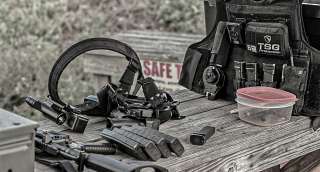Blessed be the Lord my Rock, Who trains my hands for war,
And my fingers for battle
Psalms 144:1 NKJV
I got my first gun when I was just a little boy. It was a .22 caliber, single-shot Cooey rifle, and since Daniel Boone only needed one shot to down whatever he was shooting at, I figured he was a good example to follow. I loved that gun and I practiced until I could sling lead as well as my legendary hero, or so I thought at least. It took time, lots time, but the hours of practice shooting increasingly smaller and smaller targets eventually paid off. And that is when I learned that if you own a firearm, it’s important to train with it often.
 A gun, like a car, can provide protection and enjoyment if you know how to use it safely and train to be proficient. Cars don’t kill people, drivers of cars do so it’s important to ensure you are a proficient and safe driver. Same concept applies for guns. For those of us who carry a gun for a living, that is exponentially more true. My years in Law Enforcement, SWAT, Private Security, and as a certified law enforcement handgun instructor have taught me that if you don’t train consistently with your firearms, your familiarity, proficiency, and accuracy will deteriorate.
A gun, like a car, can provide protection and enjoyment if you know how to use it safely and train to be proficient. Cars don’t kill people, drivers of cars do so it’s important to ensure you are a proficient and safe driver. Same concept applies for guns. For those of us who carry a gun for a living, that is exponentially more true. My years in Law Enforcement, SWAT, Private Security, and as a certified law enforcement handgun instructor have taught me that if you don’t train consistently with your firearms, your familiarity, proficiency, and accuracy will deteriorate.
A good friend who currently serves in Law Enforcement invited me and two other police officers to a range that allows those who are qualified, to train in more advanced tactics involving moving and shooting, multiple targets and so on. Training how you fight means that you wear the same gear that you do when you are working so everything feels and performs as it would when you are on the job. Sadly, most ranges don’t allow that but this range does making the time training there absolutely invaluable.
The standard protocol for most people when training at the range is to hang a paper target, load up a few magazines with ammo, and fire away hoping most of the rounds hit the target, and preferably close to the center. The problem is that if you have a bad habit, and you put 50 rounds through your gun without correcting it, you just practiced a bad habit 50 more times. You are effectively training yourself to become better at being inaccurate.
The better approach is to hang your target, then take your time ensuring your grip is correct, and your stance and sight picture are good. Then most importantly, your trigger pull should be a slow and smooth squeeze and when the gun goes off, it should surprise you. Then hold the trigger down for a split second before you slowly release it until it clicks. That is called the reset and you want to hold your trigger in that position then slowly squeeze the trigger again until it surprises you by going off. If you do this consistently you will be more accurate because the less movement you have with your trigger finger and the smoother that minimal movement is, the less you are moving the barrel of the gun so your shot will be more accurate.
When I train I always have a plan of what I want to accomplish that day. I start with practicing fundamentals to make sure I have no bad habits. Then I load 3 rounds into 3 or 4 magazines and place them on my body in the same place I would if I were working. I grip and draw the weapon ensuring everything is correct and clean, acquire my sight picture, and then I slowly squeeze the  trigger until the gun fires, release my trigger back to the reset, and start the trigger pull sequence the same way again. After exhausting my magazine, I methodically go through the magazine change sequence to ensure it is smooth and efficient because smooth and efficient translates into fast once it is perfected. I start this segment of my training by moving slowly and deliberately and intentionally thinking and evaluating every stage of drawing and firing the weapon so I can identify problems if they exist and fix them immediately. Once I am confident that I am squared away, I slowly increase the speed of the drawing and firing sequence, then move onto whatever tactics and skills I want to train that day. If I am at a range that does not allow advanced training then I usually end my training session here.
trigger until the gun fires, release my trigger back to the reset, and start the trigger pull sequence the same way again. After exhausting my magazine, I methodically go through the magazine change sequence to ensure it is smooth and efficient because smooth and efficient translates into fast once it is perfected. I start this segment of my training by moving slowly and deliberately and intentionally thinking and evaluating every stage of drawing and firing the weapon so I can identify problems if they exist and fix them immediately. Once I am confident that I am squared away, I slowly increase the speed of the drawing and firing sequence, then move onto whatever tactics and skills I want to train that day. If I am at a range that does not allow advanced training then I usually end my training session here.
I enjoy working with my firearms for recreation, but for work, I need to make sure that I am prepared to win a gunfight in the unfortunate event I am forced into one and that requires mastering advanced skills. Standing static in front of a target is not realistic to what will probably happen in a gunfight. Moving and shooting forward and back then laterally in both directions, changing from strong to support hand, one-handed shooting, shooting from cover and so on is very challenging. If you want to master these skills you need to train in an environment where you can practice them consistently and often.
A very important part of training is evaluating your technique but it’s impossible to do objectively and completely without either someone watching you that is knowledgable or even better, shooting a video of your training so you can evaluate and correct things you may not even realize you are doing. That’s why I like going to the range with other advanced professionals as we can always learn something of value from each other as well as identify things that need to be adjusted to become more efficient and effective.
It’s not about shooting a good target, it’s about perfecting fundamentals, then movements so that everything is smooth, efficient, and fast as well as accurate. Efficient and precise movement means you get effective rounds downrange more quickly. Working for hours to shave mere tenths of a second off the time it takes to draw your weapon and shoot accurately can mean the difference between life and death.
It’s precision training, fine-tuning, seating good habits, and developing consistently effective results. This is what wins gunfights. So this is what range day looks like.
If you own and carry a gun, I strongly urge you to train consistently both on the range with live ammunition, and dry firing at home. These skills are perishable so no matter how much experience you have, practice is necessary to be safe and effective in the unfortunate event you are forced into a gunfight.
If you are interested in tips and other interesting stuff related to firearms and firearm training I invite you to my new Locals Channel. It’s all free and devoted to helping people be safer and more informed.





